How Do Dress Sizes in the 50s Compare to Today
A brief history of sizing systems

The fashion and retail industry has come a long way to make the shopping experience as convenient as it is today, but there's one area where things seem to only get more confusing as time goes on — sizing. All these numbers and letters that are supposed to make it easier to find an outfit that fits often do the opposite, creating a less than ideal purchasing process for everyone involved. So how did we get here?
The origins
Universal sizing is a fairly recent invention, with the earliest records resembling contemporary measurement standards dating back to the Middle Ages.
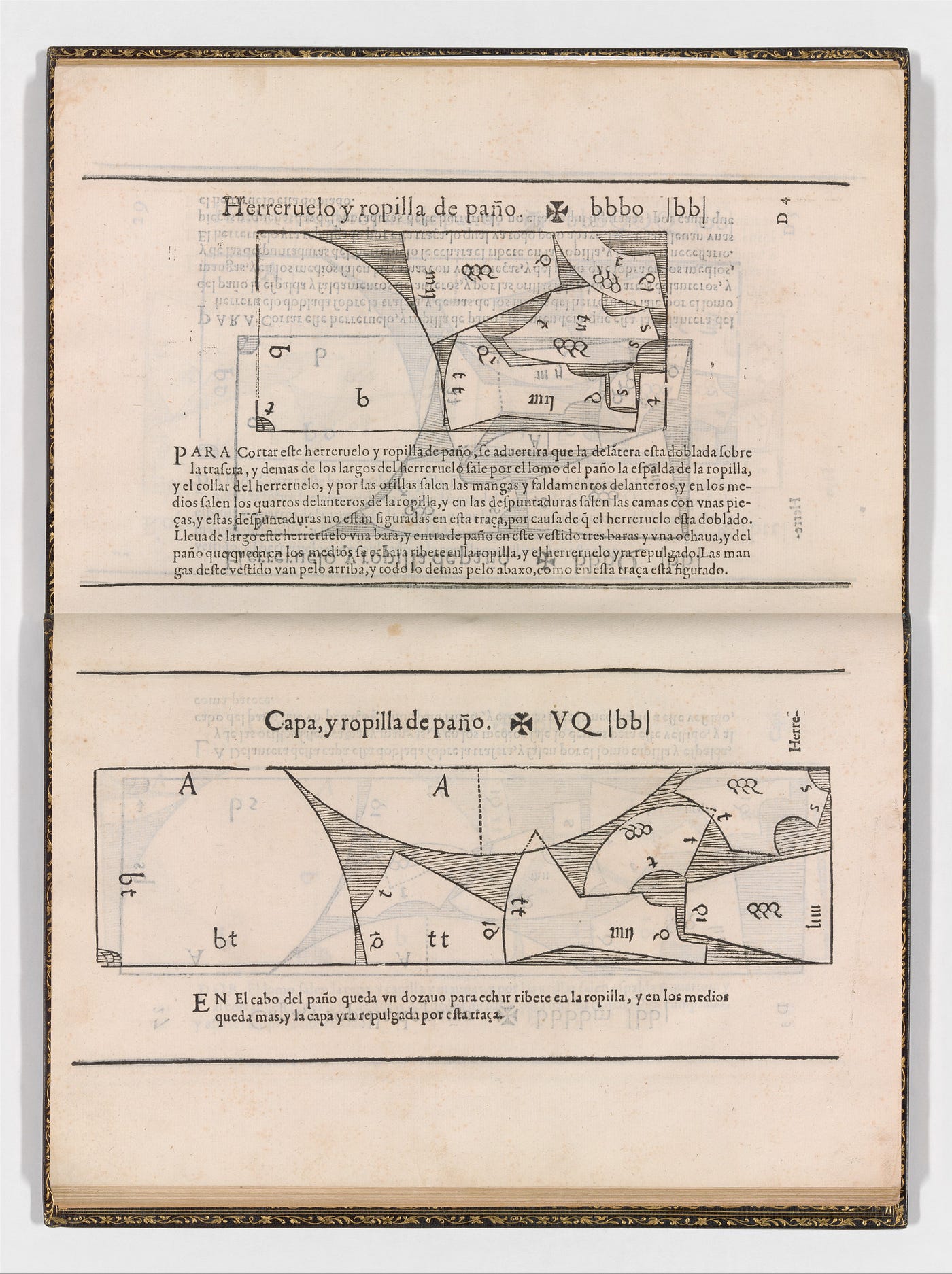
In 1589 Juan de Alcega, a Spanish tailor and mathematician, authored one of the first written works on tailoring complete with illustrations of pattern shapes.¹ His main concern, however, was the amount of cloth of varying widths required for each garment. This is not strictly speaking a matter of sizing. A general understanding of the purchase and ownership of clothes prevailed until the 19th century: garments were made individually, so they had to be ordered in advance and were generally available to a limited number of wealthy people. Following a measuring session, the tailor would pattern, cut and assemble each item from scratch, which involved a huge amount of work. And when, in the early 19th century, tailors finally started sharing their methods by publishing them, it was only to discover the disarray of metric systems and a total lack of sizing standards.
As with so many technological advancements made over the course of human history, the development of universal sizing was ultimately spearheaded by war. The Napoleonic Wars (1803–1815), the Crimean War (1853–1856) and the American Civil War (1861–1865) required unprecedented numbers of uniforms and so full-body sizing systems were developed, making it possible to calculate other parameters based on a single chest measurement.
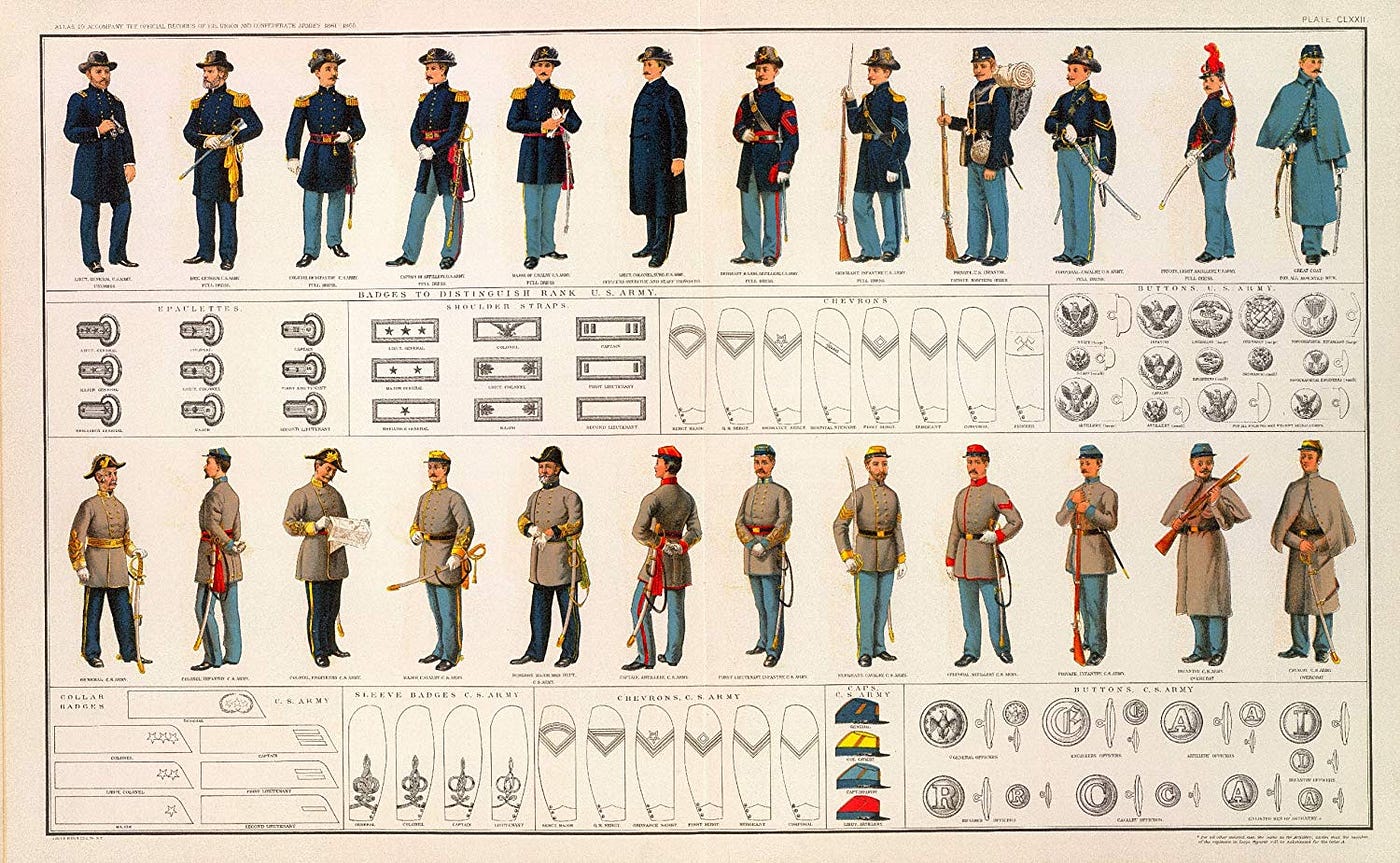
Gradually, the mass production of uniforms transformed into the production of ready-made clothing for everyone and, by the end of the 19th century, the vast majority of urban male populations in Europe and North America were wearing mass-produced, standardised clothing. Ready-to-wear menswear gradually became more industrialised, while womenswear continued to be identified with the domestic sphere and dressmakers' workrooms.
Men's and women's garment sizes are generally based on different systems. Men's clothing sizes are primarily defined in terms of body measurement, which were based on chest size. Women's clothing sizes are given in coded numbers that correspond to bust, waist, hip and height measurements.
Sizing in the UK
After the Crimean War, an expansion in white-collar jobs led to a corresponding increase in demand for suits among the middle classes, but the garments were not cut to individual sizes. They were drafted in various basic sizes. To tailor a customer's 'bespoke' order for a jacket, the closest chest size pattern was selected and alterations were made to the pattern where the customer's measurements differed from standard measurements. Chest measurements varied from 16 to 23 inches. Some manufacturers simply bought one well-tailored jacket and took it apart in order to obtain a basic model pattern that could be graded (proportionally increased in size) and altered to shape and fit.
A large number of size charts for men were published by the bespoke tailors. A comprehensive chart covering chest sizes from 21 to 36 inches was provided for children by prominent outfitter Vincent as early as 1890.²
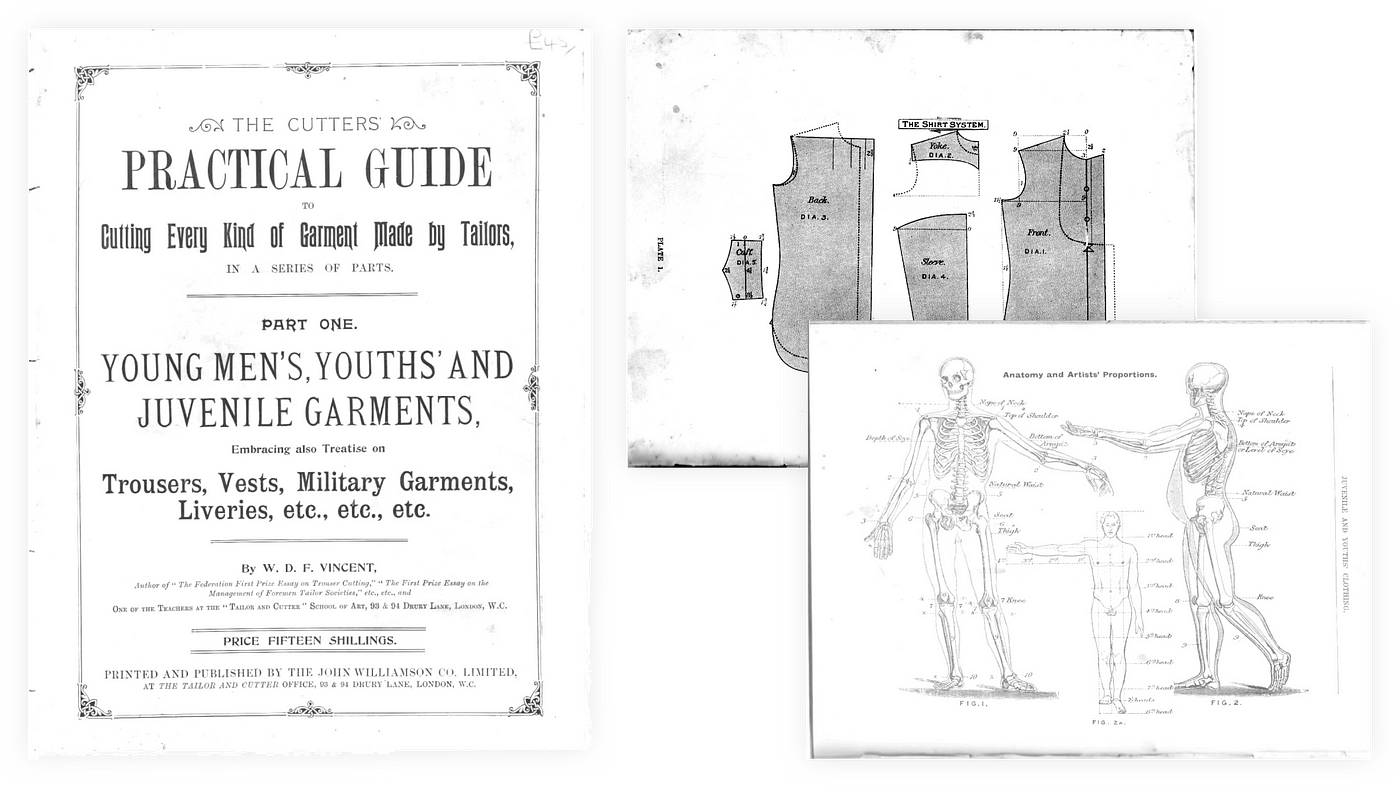
The First World War gave a boost to factory production and clothing factories were suddenly in possession of huge numbers of male body measurements. Then in Britain, the Leeds and London sizing systems, which were based on chest and waist sizes, heralded the advent of standardisation. It was the Leeds system that was finally accepted as a universal system in the country.³
Women's fashion was not so fast to abandon its close body-fitting practices, which delayed the development of sizing systems and ready-to-wear clothing. Women who could afford to visit a tailor were likely to have non-standard body measurements, the result of years of wearing corsets, and so the size patterns used to make garments for them were not representative of female populations at large.

Between 1908 and 1913, Paris fashions finally moved away from the corseted figure, and a more natural shape began to make way for the development of affordable, ready-to-wear women's clothing. Women's attitudes towards wearing readymade clothing also began to change, and it began to be accepted as a smarter form of dressing.
At the beginning of the 20th century, many British manufacturers adopted the American sizing system, as most of the size charts available in Britain at the time were conflicting and confusing.⁴ Early British sizing often had two-inch margins of error in the bust, waist and hip sizes (chest sizes in the case of children's garments) for dresses and blouses. Sets of codes, such as SW, W, OS, XOS, EOS, XXOS and SOS were used by the wholesale trade in mantles (a type of loose-fitting outer garment). Manufacturers could set average women's sizes thanks to Bridgland's table — which gave them a range of measurements (36–38 inches) — depending on their clientele. Sizing in other European countries, meanwhile, differed from the British model and was measured in centimetres.
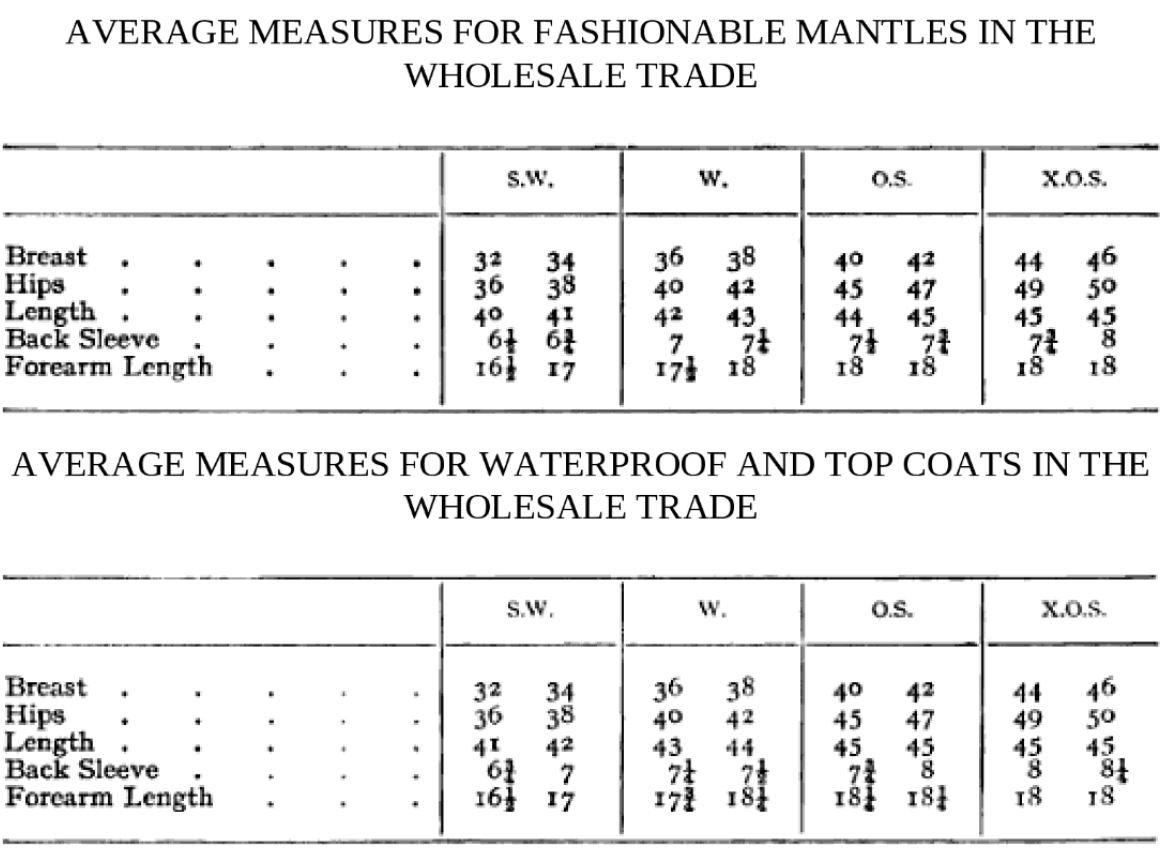
The British Standards Institution received a Royal Charter in 1929 and the first standard to provide body measurements, BS 1445, was introduced in 1951 in the midst of a national drive for post-war industrial recovery and the social and physical improvement of the general population. The Clothing Industry Development Council was concerned about losses to labour and materials, particularly in the women's segment of the market, as well as the scale of alterations to clothing being observed. Seventeen measurement specialists grouped into five teams traversed the country, carrying out their work in retail establishments, factories, offices, women's organisations, colleges and schools.
In 1970 a labelling system for childrenswear was introduced, similar to that provided for womenswear. It recognised impending metrication by including height, a response to the centilong system that sized and categorised children by height measurement intervals and was already in place in other European countries.

As part of Britain's shift to the metric system, the sizing system was modified (see BS 3666:1974) to reflect the new units of measurement.¹ BS 3666 saw further modifications over the coming decades. In 1982 there was an attempt to apply a system with four-centimetre intervals, which is more flexible than the BSI's system. The switch to the new system was a failure for the clothing retail industry, with most retailers and customers still using inches for measurements.
Sizing in the USA
During the American Civil War, federal agents took measurements from thousands of recruits and discovered patterns for combined chest, waist and leg measurements. This ultimately formed the basis for a single set of sizes that was rolled out to civilian menswear. Average-size suits were then made available with variations in length and fitting too.
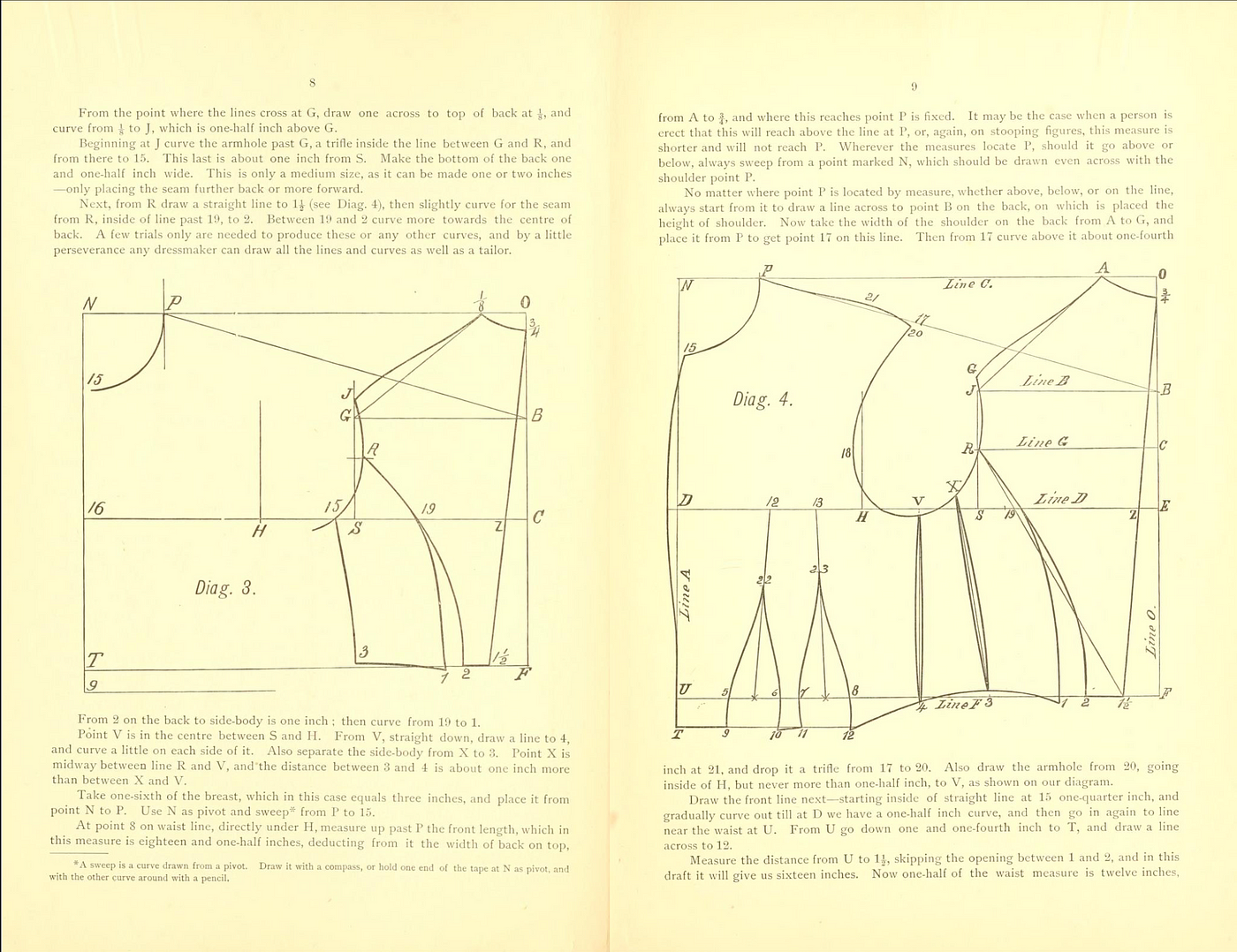
In 1881, the American tailor Charles Hecklinger created the first systematic methods of block adaptation for women. This involved the creation of 'generic' patterns for a range of body types. Variations in breast and hip sizes were difficult to reduce to a single size number. The biggest challenge was the bust shape — the three-dimensional differences in size, and the proportional differences between waist and bust measurements among different women were not accounted for by the sizing systems of the time, so a made-to-measure suit still required up to 11 body measurements. Nevertheless, by 1890 the American contractors had taken over 90% of the cloak and suit trade.
Statistical approach
In 1939, the US government funded statisticians to collect weight measurements and 58 size measurements for 15,000 women — they were looking for key measurements that could predict other body measurements. They used only white women in the study, however — even though they took measurements of women of colour, they didn't include them in the research. Furthermore, the body models were rewarded for participating in the study, and so poorer women were more likely to turn up. As a result, the data set represented a not particularly diverse group of women, even potentially including some who were suffering from malnourishment.
In 1958, the now-famous sizing system with numbers ranging from 8 to 42 was created. These were in fact arbitrary numbers based on bust size, combined with a letter to denote height and either an increase ('full') or decrease ('slender') in the size to account for hip measurements. This sizing system was unpopular, however, and not generally accepted, so it was modified in 1970 in accordance with changes in consumer tastes and body types.
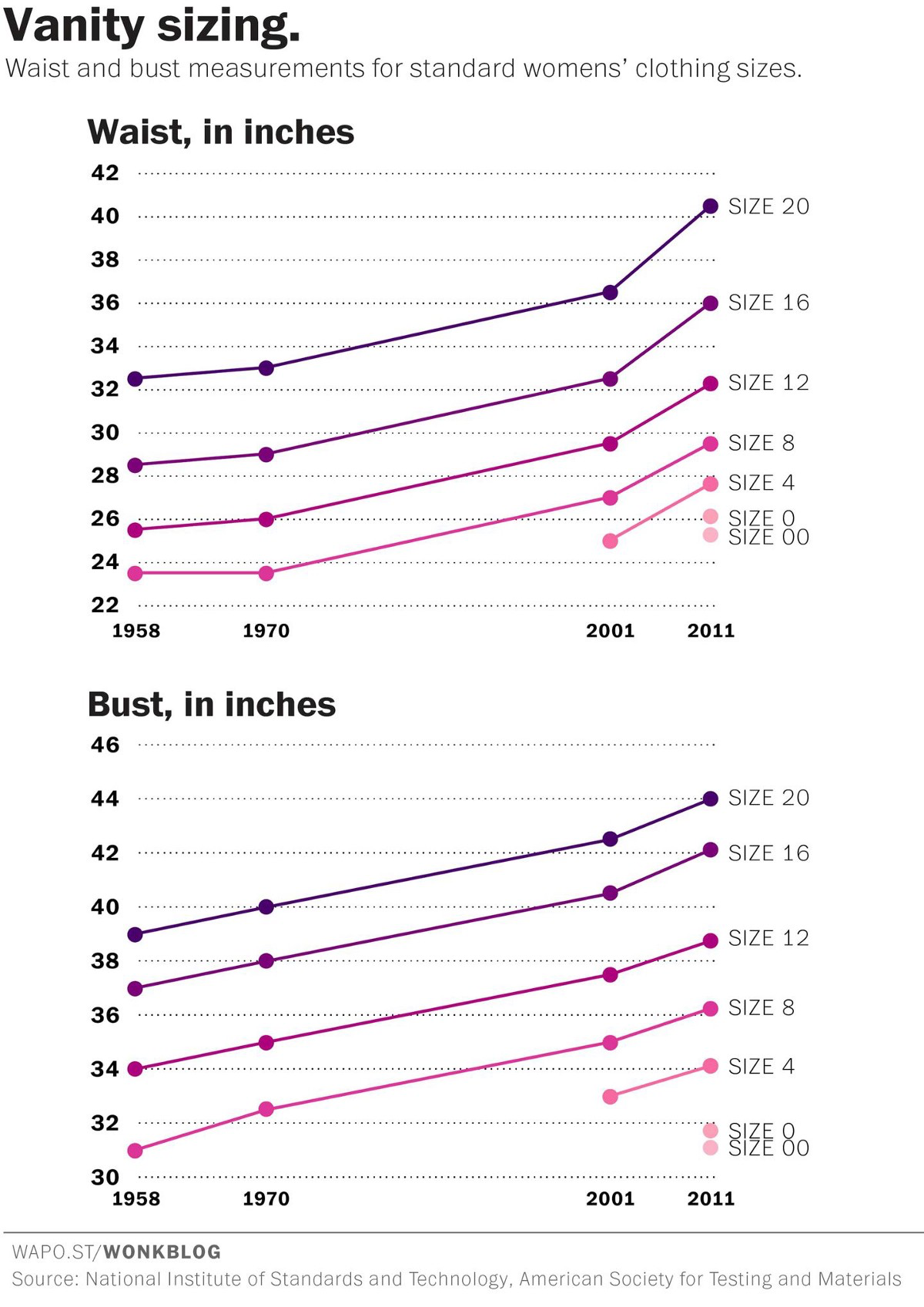
And then, in the 1970s and 1980s, just as a glimmer of hope for a clear, universal sizing system appeared, garment companies began downgrading size labels and adding lower numbers like 2, 0 and later even 00. A waist measurement that would have previously been categorised as a size 12 became an 8. This is known as vanity sizing, where the size on the label is reduced in number to encourage customers to buy the garment, taking advantage of consumer body image aspirations. This is how sizing became a marketing tool, instead of simply being a vehicle for sizing (which it wasn't very good at in the first place). These sizing systems existed free from any government regulation until finally, in 1983, the United States Department of Commerce completely withdrew the sizing system of the 1950s.
In 1995, the American Standards for Testing and Materials (ASTM) International (created in 1898) published its own non-mandatory sizing standard. Here we can see the beginning of rapid size deflation. The 1995 ASTM standard lists a size 2, but in 2011 they list a standard for size 00. Marilyn Monroe was a size 12 in the 1960s, but today she would be a size 6. In fact, the ASTM represents a continuation of the 1958 system, but that system was not in the public domain at the time.
There is another factor explaining why sizing systems no longer work. People are larger than ever before. The Textile Clothing Technology Corporation conducted the first widespread study of American women's bodies, called SizeUSA. They scanned the bodies of almost 11,000 people between the ages of 18 and 80 in 13 locations across the country. The study identified nine distinct body shapes for women. The 'hourglass ideal' that has long set the standard for women's clothing sizes in fact only rings true for 8% of American women. Analogous surveys were conducted in the UK (SizeUK), South Korea (SizeKorea) and Mexico (SizeMexico).
International sizing
European tailors were the first to show an interest in anatomical body measurements and their proportions. A diagram of measurements taken from naked bodies was found in a German tailoring book written by J.G. Bernhardt and dated 1810–1820. Bernhardt published a well-developed system for women's sizing that illustrates the great differences in clothing production for women in various parts of Europe. In 1822, E. A. Bardé described two scale methods for grading. In one method, the pattern is drawn onto square paper, with the squares representing the bust measurements. The pattern can then be adjusted for larger or smaller sizes. For Bardé's other method, the pattern size is modified by means of different lengths of grading tape with smaller or larger increments. This method was also used by artists, architects and sculptors. It was easier to make calculations because the measuring strip could be easily folded into the correct parts.
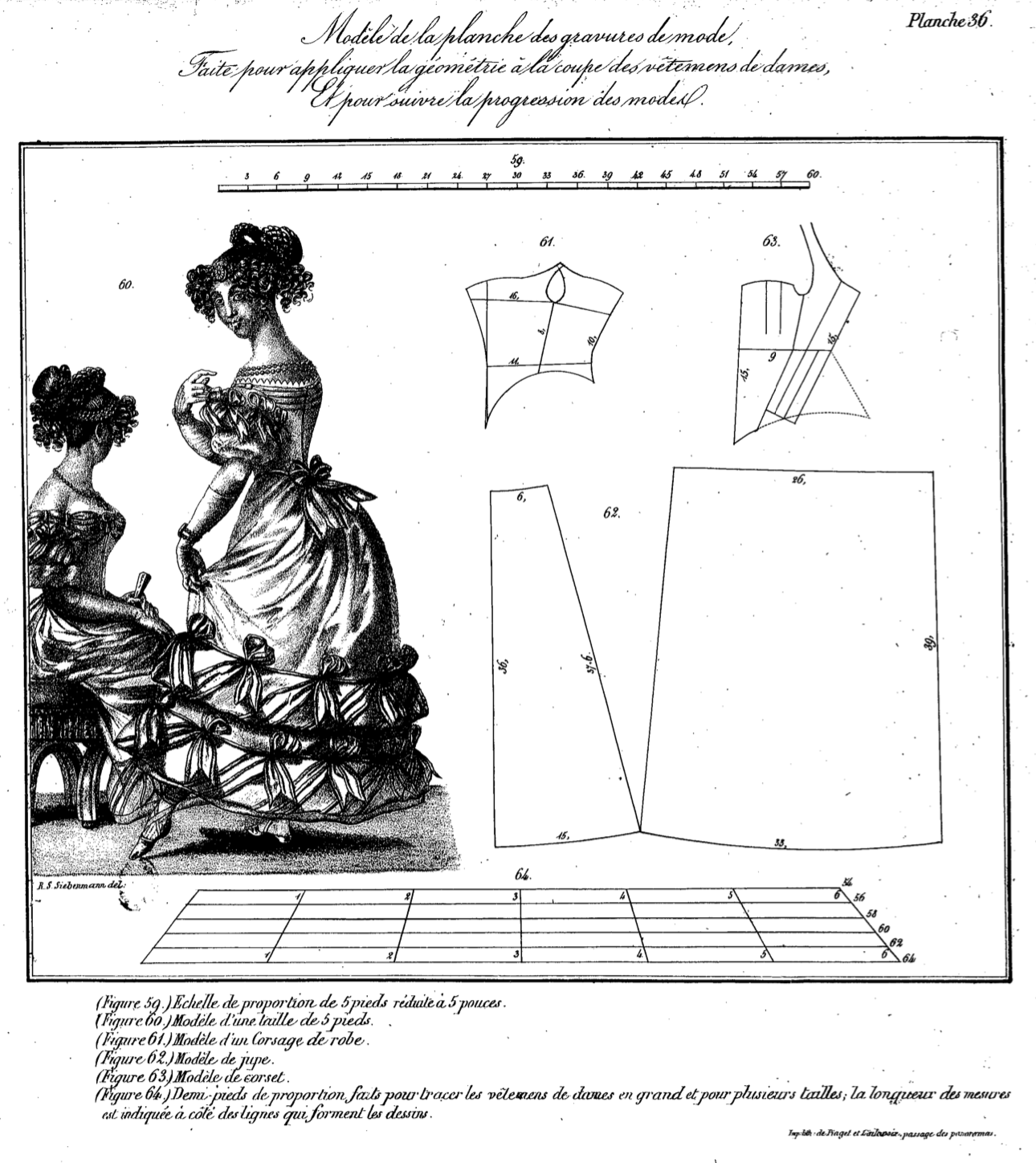
Another grading system, created by french tailor Guillaume Compaing, was based on a method used by architects who divided rectangles into squares to create drawings at different scales.⁶ He realised that if strips of paper representing different breast sizes could be divided into a number of equivalent units, any basic pattern construction could be then scaled to a larger or smaller size. The system was later used in centimetres and inches by tailors across Europe and America. In 1885 W.B. Pollock applied for the first patent in the field of clothing size measurements.⁷ During the process, he discovered that the populations of many developed countries had on average grown in height.
The global standard
The International Organization for Standardization (ISO), established in 1946, was a response to the desire among many countries for international harmonisation of standards. The founders included the Soviet Union, Australia, China, India and a number of European countries, with international sizing systems starting to be developed in 1969.¹ The various countries conducted research into the measurements of their populations. For instance, during 1957–65 the USSR measured major population groups from various parts of the country, and in 1966–67 Japan created its own standard, JIS, based on the measurements of 35,000 people.⁷
Europe
Other countries have also made efforts to develop sizing standards. In 1966 tables of measurements for men's and boys' outerwear were issued in Germany, including 88 commercial sizes. Thanks to the growing importance of the European market, the tables included European sizes. German sizes were designated separately in accordance with the recommendations of the Association européenne des industries de l'habillement (European Association of Clothing Industries).
China
China began to develop apparel sizing standards in 1974 and implemented its own standard (GB 1335–81) in 1981, which was then updated in 1991 after an anthropometric survey had been carried out in 1987.⁸ Making these standards readily available to producers of apparel around the world would prove to be crucial. ASTM International and the Standardization Administration of China signed a memorandum of understanding in 2004.
New(er) developments
The German-based DOB-Verband (the women's outer garment association) published a sizing system in 1983 which identified nine figure types with height relative to hip as the key dimension. The Korean Standards Association uses five height groups in its sizing system (1990). In 1992–94, Japan became the first country to use a 3D scanner for anthropometric measurements.
Alpha sizing: S, M, L and XL
These sizes have long been used for t-shirts and stretchy casual clothing. Brands now combine two or three numerical sizes into a single letter size. Many brands are also utilizing stretchy fabrics with more give, making precise sizing less essential. That changed as alpha-size sportswear grew in popularity and new fabrics with more stretch, like lycra, arrived on the market.
Alpha-based sizing is a part of the EN 13402 European standard, which was first developed in 1996. Its letter coding simplifies the production process, with fewer different-sized items to manufacture. It also simplifies transposition into international sizes and makes online shopping easier for customers. Retailers have found that the male segment, who are increasingly shopping for their own clothes, prefer alpha sizing.
Modern issues
Today, fashion brands and retailers have to cater to the whole world in all its diversity, so they tend to focus on certain demographics and home in on what sells best with them. As a result, different brands owned by the same corporation will often have inconsistent sizes. Add to that the different sizing systems between countries and other regional peculiarities, and the resulting situation is one of confusion and no consensus.
For instance, based on an international sizing chart for women with an average height of 164 cm, a clothing size of 14 in the US corresponds to a 16 in the UK, 44 in France, 42 in Germany and 48 in Italy. It becomes clear that knowing your clothing size is virtually impossible. Now, thanks to Sizolution, that doesn't matter.
Sizolution measures your exact body shape instantly and finds the right size for you. Every time. Stay tuned.
Source: https://medium.com/sizolution/a-brief-history-of-sizing-systems-aee6bd066834
Post a Comment for "How Do Dress Sizes in the 50s Compare to Today"